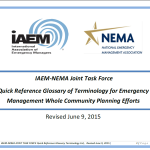Accessibility & Inclusive Resources
1. SHELTERING ACCESSIBILITY - FOUNDATIONAL DOCUMENTS
ADA CHECKLIST FOR EMERGENCY SHELTERS (July 2007)
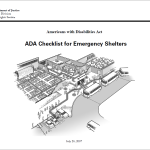
One of the most important roles of state and local government is to protect people from harm, including helping people obtain food and shelter in major emergencies. When disasters occur, people are often provided safe refuge in temporary shelters located in schools, office buildings, tents, or other facilities. Advance planning for an emergency shelter typically involves ensuring that the shelter will be well stocked with basic necessities, such as food, water, and blankets. Planning should also involve ensuring that these shelters are accessible to people with disabilities. Making emergency sheltering programs accessible is generally required by the Americans with Disabilities Act of 1990 (ADA).
GUIDANCE ON PLANNING FOR INTEGRATION OF FUNCTIONAL NEEDS SUPPORT SERVICES IN GENERAL POPULATION SHELTERS (November 2010)
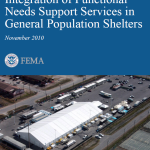
Planning guidance that can be incorporated into existing shelter plans to State emergency managers and shelter planners to meet access and functional needs in general population shelters. This document provides guidance to assist emergency managers and shelter planners in understanding the requirements related to sheltering children and adults with functional support needs in general population shelters. Functional Needs Support Services (FNSS) and the guidance provided are designed to assist in the planning and resourcing of sheltering operations whether government, NGO, faith- or private-based to meet the access and functional needs of children and adults. These guidelines identify methods of achieving a lawful and equitable program through the delivery of FNSS for children and adults.
ADA STANDARDS FOR ACCESSIBLE DESIGN (September 2010)
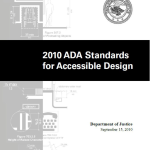
The Department of Justice’s revised regulations for Titles II and III of the Americans with Disabilities Act of 1990 (ADA) were published in the Federal Register on September 15, 2010. These regulations adopted revised, enforceable accessibility standards called the 2010 ADA Standards for Accessible Design, “2010 Standards.” On March 15, 2012, compliance with the 2010 Standards was required for new construction and alterations under Titles II and III. March 15, 2012, is also the compliance date for using the 2010 Standards for program accessibility and barrier removal. Of note, these standards apply to Mass Care Sheltering.
2. ACCESSIBILITY IN EMERGENCY MANAGEMENT & MASS CARE - EXAMPLES OF LEGAL PRECEDENCE
3. INDUSTRY BEST PRACTICES - ACCESS AND FUNCTIONAL NEEDS
SHELTERING SENSORY ITEMS (March 2024)
A resource for partners on sensory items for emergency shelters. Partners and subject matter experts attended various listening sessions regarding the use of sensory items in post disaster high stress situations.
The purpose of this document is to support individuals with autism spectrum disorder (ASD) who may show sensory sensitivities demonstrating either over-or under-reactivity to particular lights, smells, sounds, tastes, and/or touch/motion. This can be exacerbated for some children and adults during times of a disaster, to include when they are sheltering. Equipping shelters with sensory items/kits/rooms/tents, may assist in reducing anxiety experienced from these challenges.
2015 IAEM-NEMA FNSS / ACCESSIBILITY REFERENCE GLOSSARY FOR EMERGENCY MANAGEMENT PLANNING
Disability, Access and Functional Needs Emergency Planning Terms of Reference June 2015
NEMA-IAEM DISABILITY AFN EMERGENCY PLANNING GUIDE (2015)
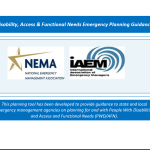
Planning for and with People With Disabilities and Access & Functional Needs (PWD/AFN) is an important component in the development and execution of emergency management plans, policies and procedures. Local jurisdictions are feeling an increased amount of pressure to incorporate the needs of PWD/AFN into their planning processes. State and local jurisdictions around the country are being faced with the challenge of effectively incorporating the needs of PWD/AFN in community engagement efforts, emergency messaging/mass notifications, evacuations and transportation, all aspects of mass care (especially sheltering), recovery, training, exercises and in the development of agreements, contracts and MOUs. This document will assist local officials with tools that will enable them to provide reasonable accommodations for their citizens during all phases of the emergency management cycle. Working to address these issues at each level of government will help to improve overall efficiency, maximize resources, ensure equal access for all citizens and ultimately enhance nationwide emergency preparedness. In addition, this document will support whole community planning initiatives by providing tips and strategies to ensure the considerations of PWD/AFN are incorporated into the framework of emergency management programs around the country.
STATE OF TEXAS – FNSS TOOL KIT (April 2015)
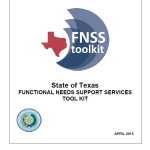
The purpose of this 2015 toolkit is to provide planning guidance, which can be incorporated into existing shelter plans. The toolkit provides guidance to assist local emergency management and shelter planners in understanding the requirements related to providing disaster related services to children and adults with and without disabilities who have access and functional needs in the state of Texas. The guidance in this document is designed to assist in planning and resource allocation for disaster response. This toolkit is designed to provide first responders and emergency management professionals basic information about interacting with Texans with disabilities during a disaster and to identify disability leaders in the local communities.
This video brought to you by the Ready Campaign and Ad Council showing people with disabilities taking charge to prepare themselves and their families for emergencies. This video is available with open caption and a certified deaf interpreter (CDI).
Video: WE PREPARE EVERY DAY (July 2015)
From the Ready Campaign and Ad Council, this video shows people with disabilities taking charge to prepare themselves and their families for emergencies.
DEPARTMENT OF JUSTICE (DOJ) – ADA BEST PRACTICES TOOL KIT FOR STATE AND LOCAL GOVERNMENTS
The Tool Kit is designed to teach state and local government officials how to identify and fix problems that prevent people with disabilities from gaining equal access to state and local government programs, services, and activities. It will also teach state and local officials how to conduct accessibility surveys of their buildings and facilities to identify and remove architectural barriers to access.
